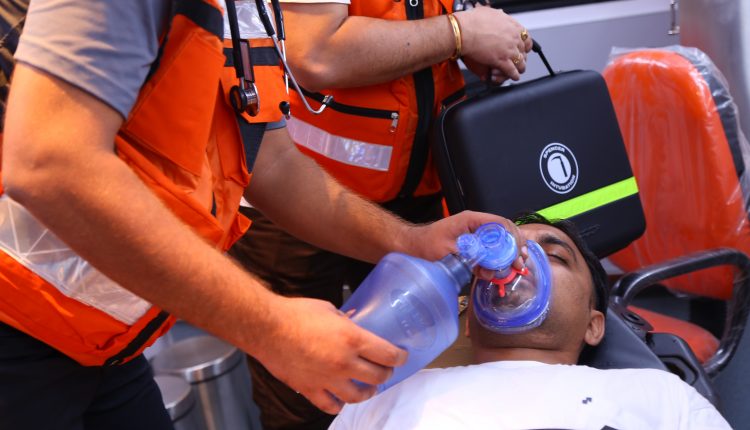
Let's talk about ventilation: what are the differences between NIV, CPAP and BIBAP?
NIV (an acronym for “non-invasive ventilation”) refers to a bloodless (non-invasive) mode of assisting lung alveolar ventilation of a patient who is insufficient for this function, without having to resort to tracheostomy, an intervention involving the creation of a surgical breach in the trachea to allow the patient to breathe with the aid of a ventilator directly connected to the tracheal route via a connecting tube, or without having to resort to the no less invasive oro-tracheal intubation (tracheal connecting tube introduced orally into a sedated patient)
When NIV is the ideal device
As mentioned earlier, both severe obesity and thoracic cage motor deficit pathologies resulting from neuromuscular diseases are ideal candidates for the use of this type of device, in relation to the great risk of seeing respiratory insufficiency worsen, initially only hypoxaemic (only O2 deficit but not CO2 deficit), until reaching a condition of oxygen deficit with a simultaneous pathological increase in the amount of carbon dioxide in the blood (type II respiratory insufficiency, also known as hypercapnic).
It is precisely the risk of progression of the severity of the hypoxaemic-hypercapnic type II respiratory failure to the point of leading to a coma due to an excess of CO2 in the blood (carbonarcosis coma) that must advise these patients to receive ventilotherapy with Bi-PAP ventilators, motivating them to maintain the treatment for as long as prescribed by the pulmonologist.
It should always be remembered that ventilotherapy, and the resulting improvement in lung ventilation that reduces CO2, is not replaceable by any alternative treatment, nor by medication alone.
Biphasic Positive Airway Pressure (BIPAP) is a ventilation modality that emerged in the second half of the 1980s and is characterised by the biphasic (i.e. on two different levels) application of continuous positive airway pressure.
BIPAP, can be applied either through an invasive or a non-invasive interface (like all conventional ventilation modalities)
Mechanical ventilators call BIPAP in different ways (BIPAP, Bi-Vent, BiLevel, BiPhasic, DuoPAP), but they all do the same thing.
In BIPAP, two different pressure levels are set which function as two different levels of CPAP.
CPAP is a mode in which the patient breathes spontaneously with continuous positive airway pressure.
This means that the inspiratory flow is not associated with increased airway pressure, as is the case when the inspiratory act is supported by the ventilator.
In BIPAP the patient therefore breathes spontaneously as in CPAP, but has two levels, and not just one as in CPAP, of continuous positive airway pressure which alternate rhythmically.
In order to be able to set up a BIPAP, four commands are therefore essential: a low pressure level (P-low), a high pressure level (Palta), a duration of P-low (T-Low) and a duration of Palta (T-High).
BIPAP is not only a spontaneous ventilation as the patient inevitably receives an insufflation when the pressure goes from Pb Low to Palta , as it happens every time the airway pressure increases during mechanical ventilation.
And just as inevitably, the patient exhales part of his lung volume in the transition from Palta to Pbassa.
Thus, BIPAP is a combination of controlled pressometric ventilation (linked to alternating Pbassa and Palta) and spontaneous ventilation, with spontaneous respiratory acts freely executable during both Pbassa and Palta.
If the patient becomes passive, he has ensured ventilation which is to all intents and purposes pressure-controlled ventilation: Pbassa becomes PEEP and the difference between Palta and Pbassa constitutes the controlled pressure level.
The time T-Palta becomes the inspiratory time, while the time T-Pbassa represents the expiratory time.
A complete respiratory cycle therefore has as its duration the sum of T-Palta and T-Pbassa and the respiratory rate becomes equal to 60/(T-Palta+T-Pbassa). If I set T-Palta of 1.5″ and T-Pbassa of 2.5″, what will be the respiration rate?
If the patient becomes active, BIPAP becomes quite different from controlled pressure.
In controlled pressure, each (successful) attempt to inhale by the patient triggers a new controlled act (i.e. the increase in airway pressure to the set level for the duration of the inspiratory time).
Here we can clearly see that the trigger triggers an act with inspiratory assistance (=with increased airway pressure) each time.
During BIPAP, on the other hand, spontaneous inhalation during Pbassa does not trigger any controlled act, but merely becomes an additional spontaneous respiratory act that intersperses the rhythm of the pressure changes.
This is a feature shared with SIMV: controlled breaths alternating with spontaneous breaths. However, it must be known that many ventilators leave a synchronisation window between the patient’s respiratory activity and the BIPAP cycles: if a patient inhales close to the transition from Pbassa to Palta, the ventilator anticipates and synchronises this transition with the spontaneous inspiratory activity, in fact reproducing what normally occurs during pressure-controlled ventilation.
The real peculiarity of BIPAP occurs when there is spontaneous inspiratory or expiratory activity during Palta: for BIPAP this is not asynchrony, but simply the patient’s breathing at one of the CPAP levels.
Read Also:
Emergency Live Even More…Live: Download The New Free App Of Your Newspaper For IOS And Android
Obstructive Sleep Apnoea: What It Is And How To Treat It
Obstructive Sleep Apnoea: Symptoms And Treatment For Obstructive Sleep Apnoea
Our respiratory system: a virtual tour inside our body
Tracheostomy during intubation in COVID-19 patients: a survey on current clinical practice
FDA approves Recarbio to treat hospital-acquired and ventilator-associated bacterial pneumonia
Clinical Review: Acute Respiratory Distress Syndrome
Stress And Distress During Pregnancy: How To Protect Both Mother And Child
Respiratory Distress: What Are The Signs Of Respiratory Distress In Newborns?
Sepsis: Survey Reveals The Common Killer Most Australians Have Never Heard Of
Sepsis, Why An Infection Is A Danger And A Threat To The Heart
Respiratory Distress Syndrome (ARDS): Therapy, Mechanical Ventilation, Monitoring



